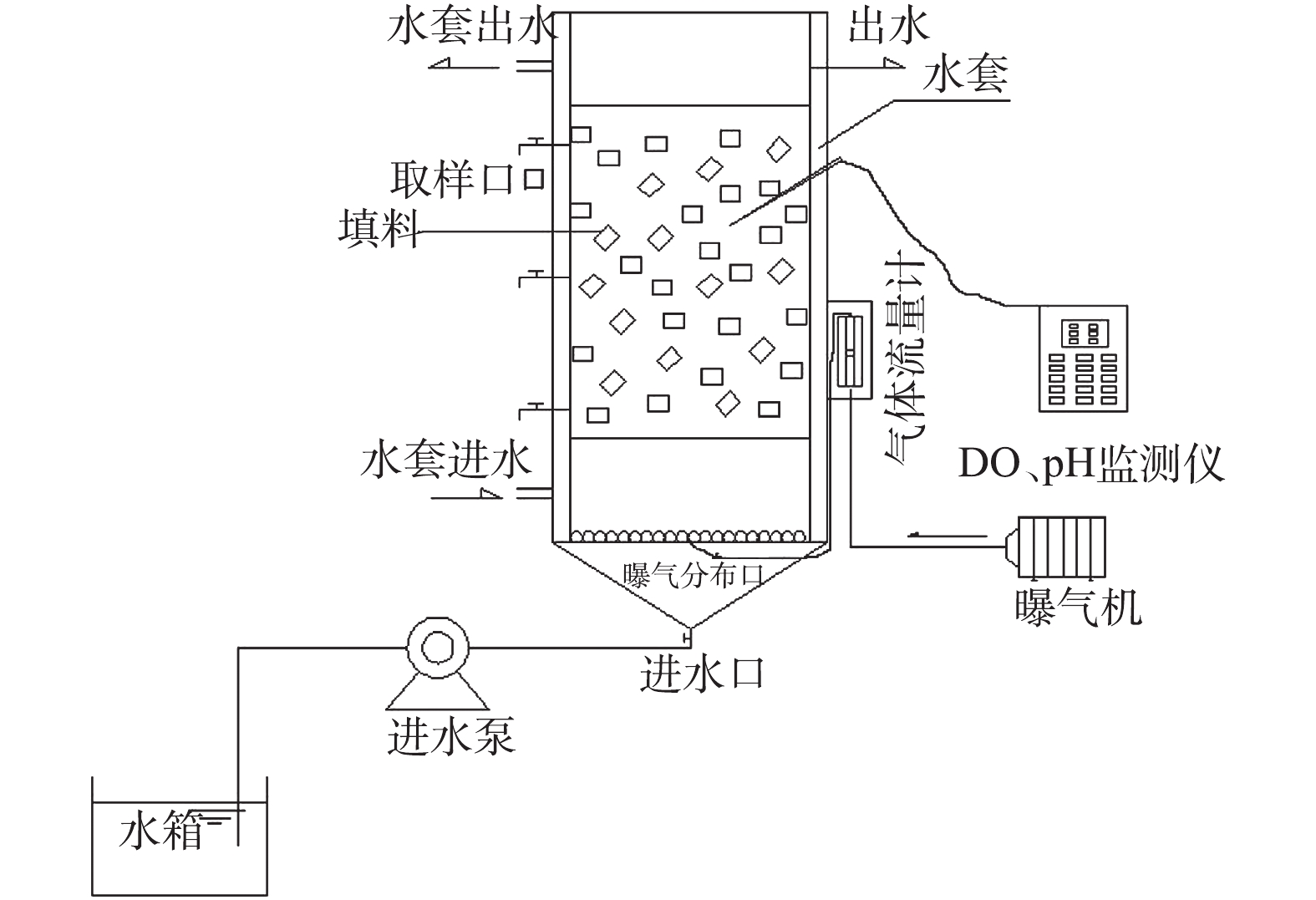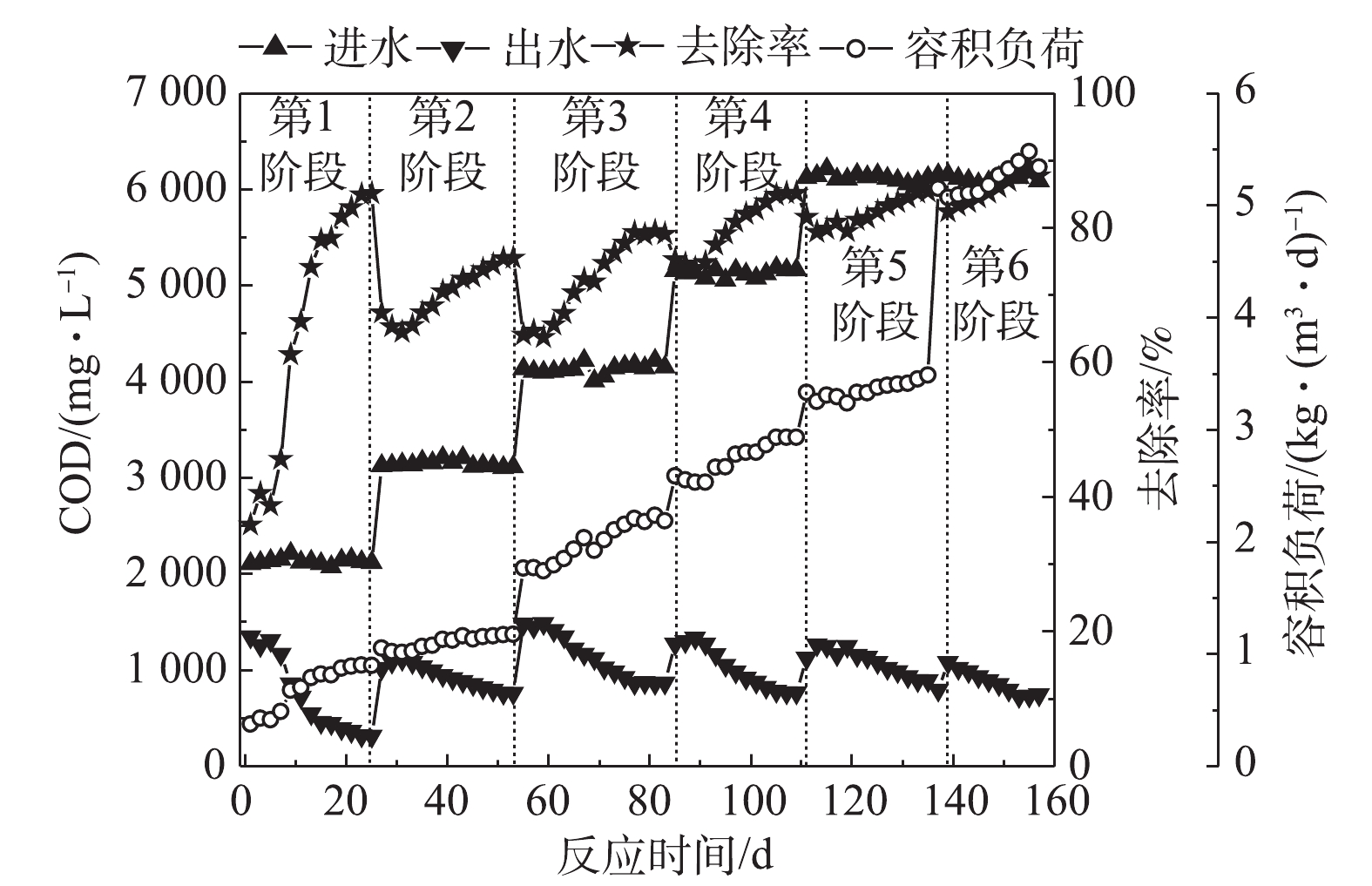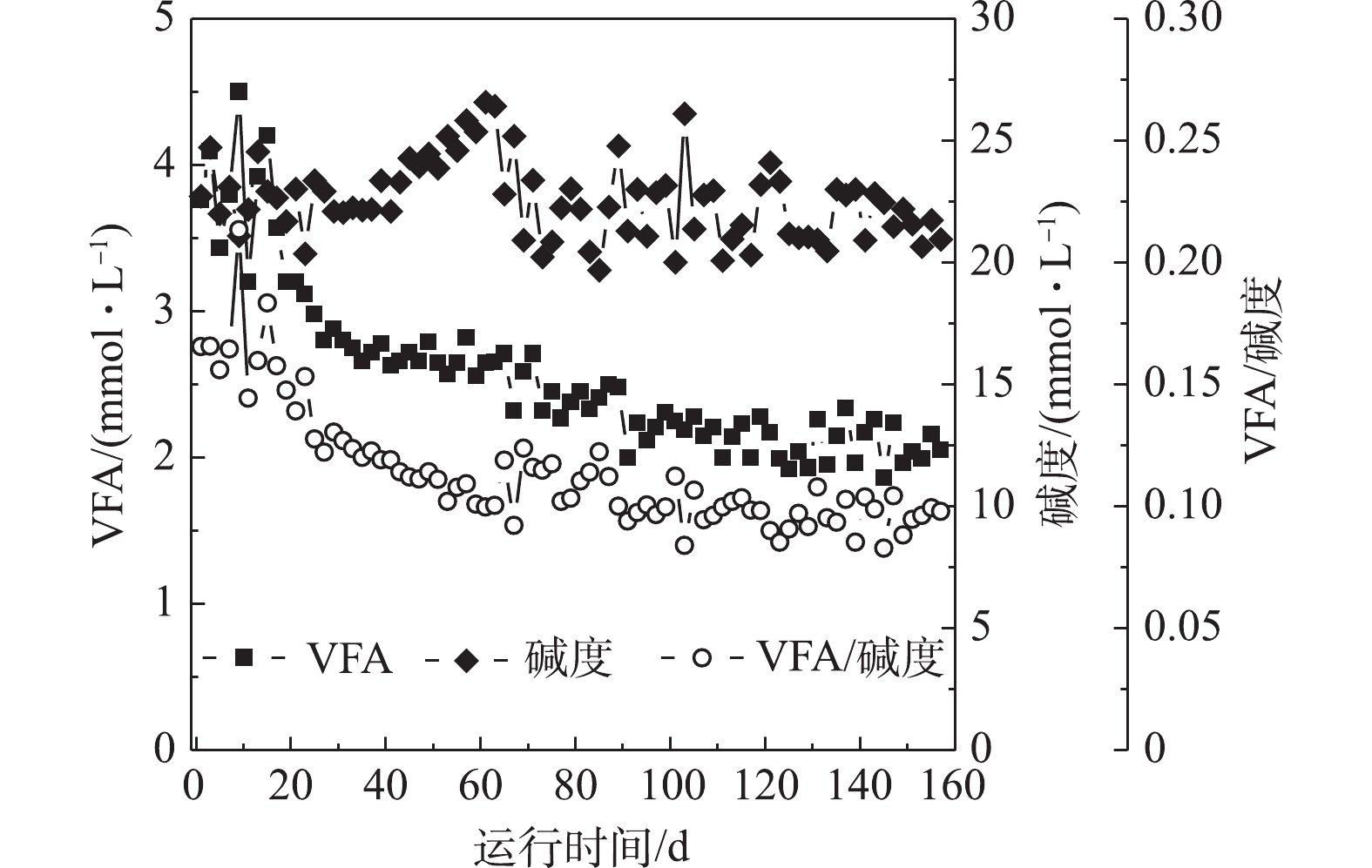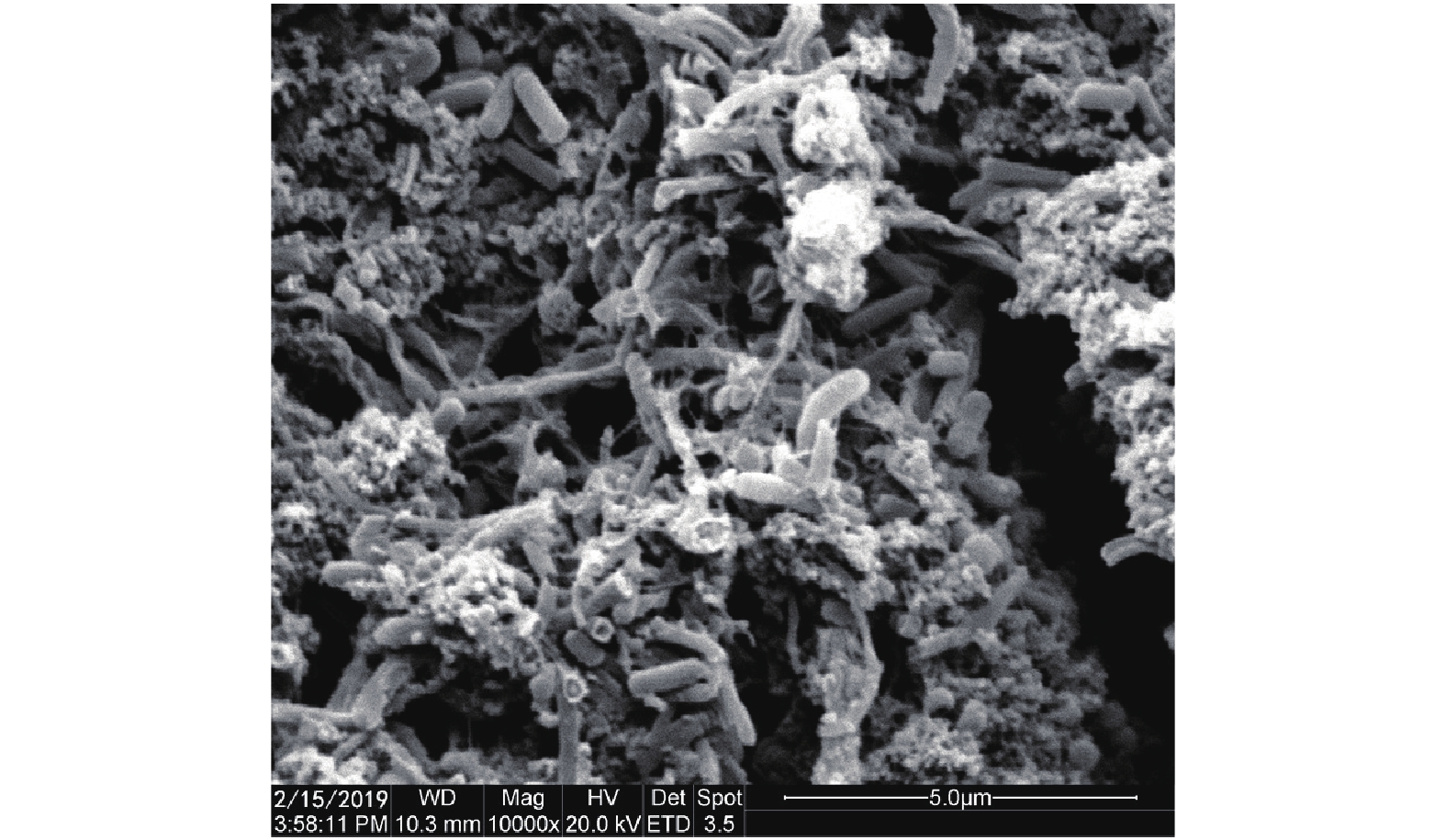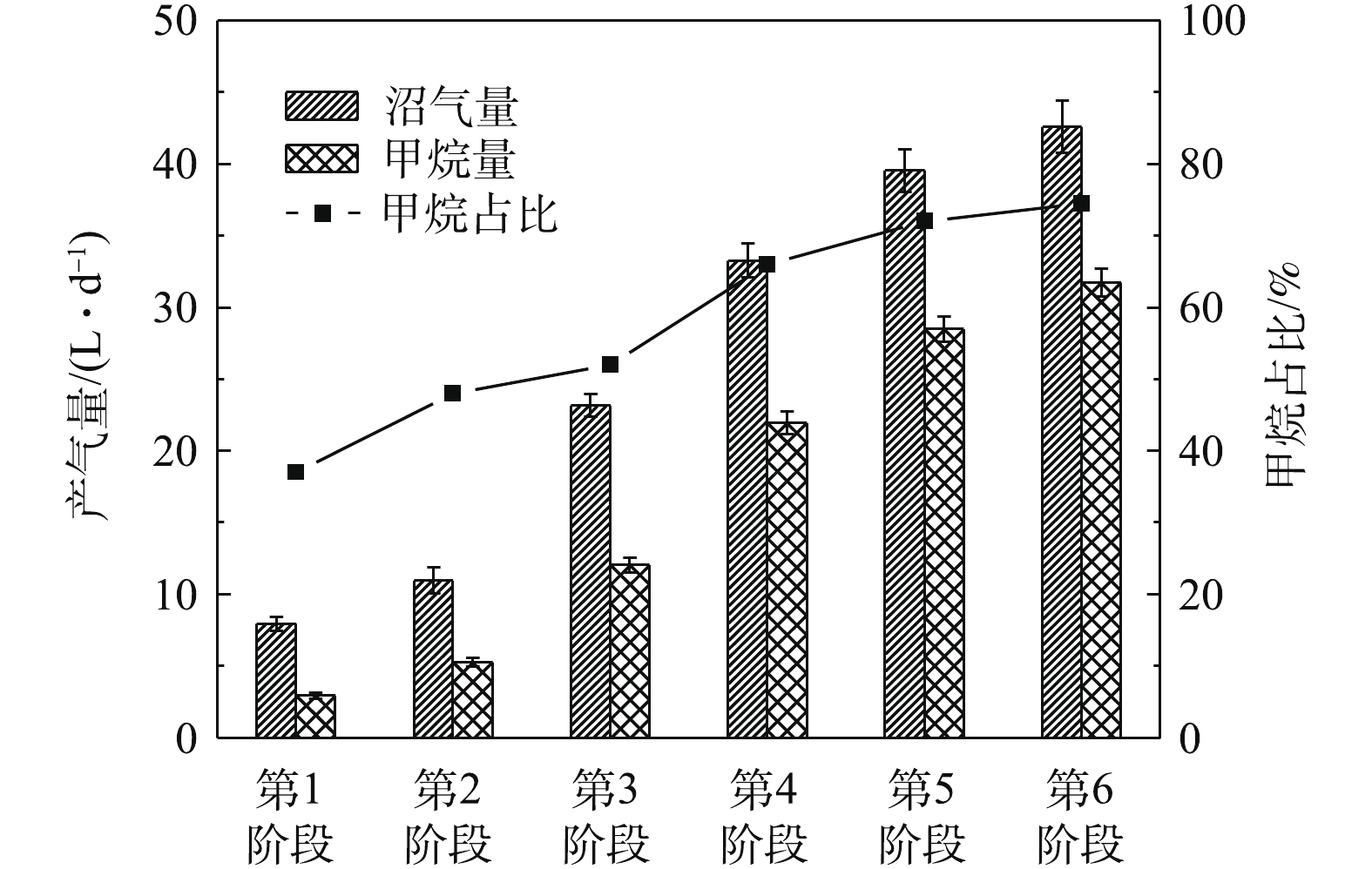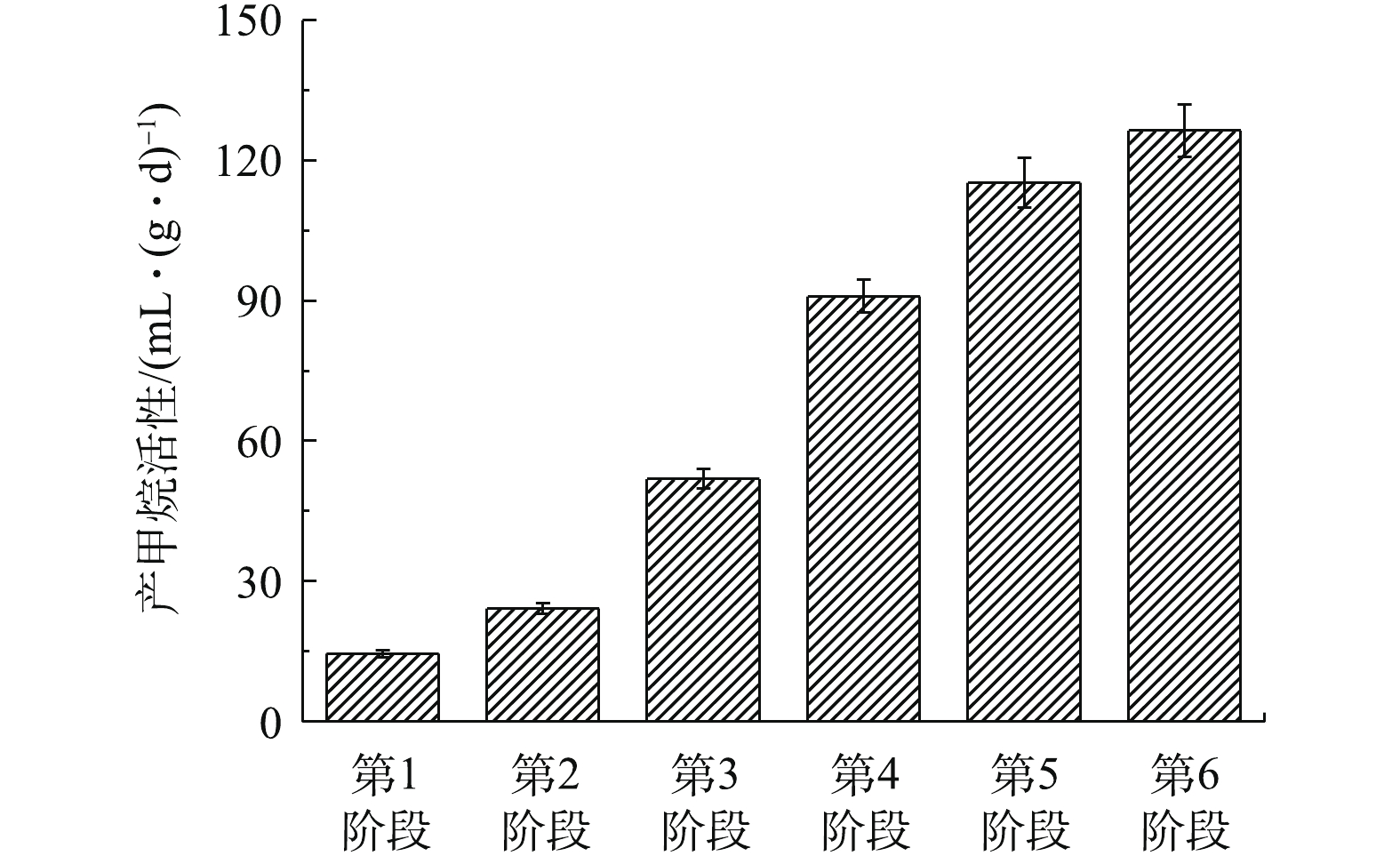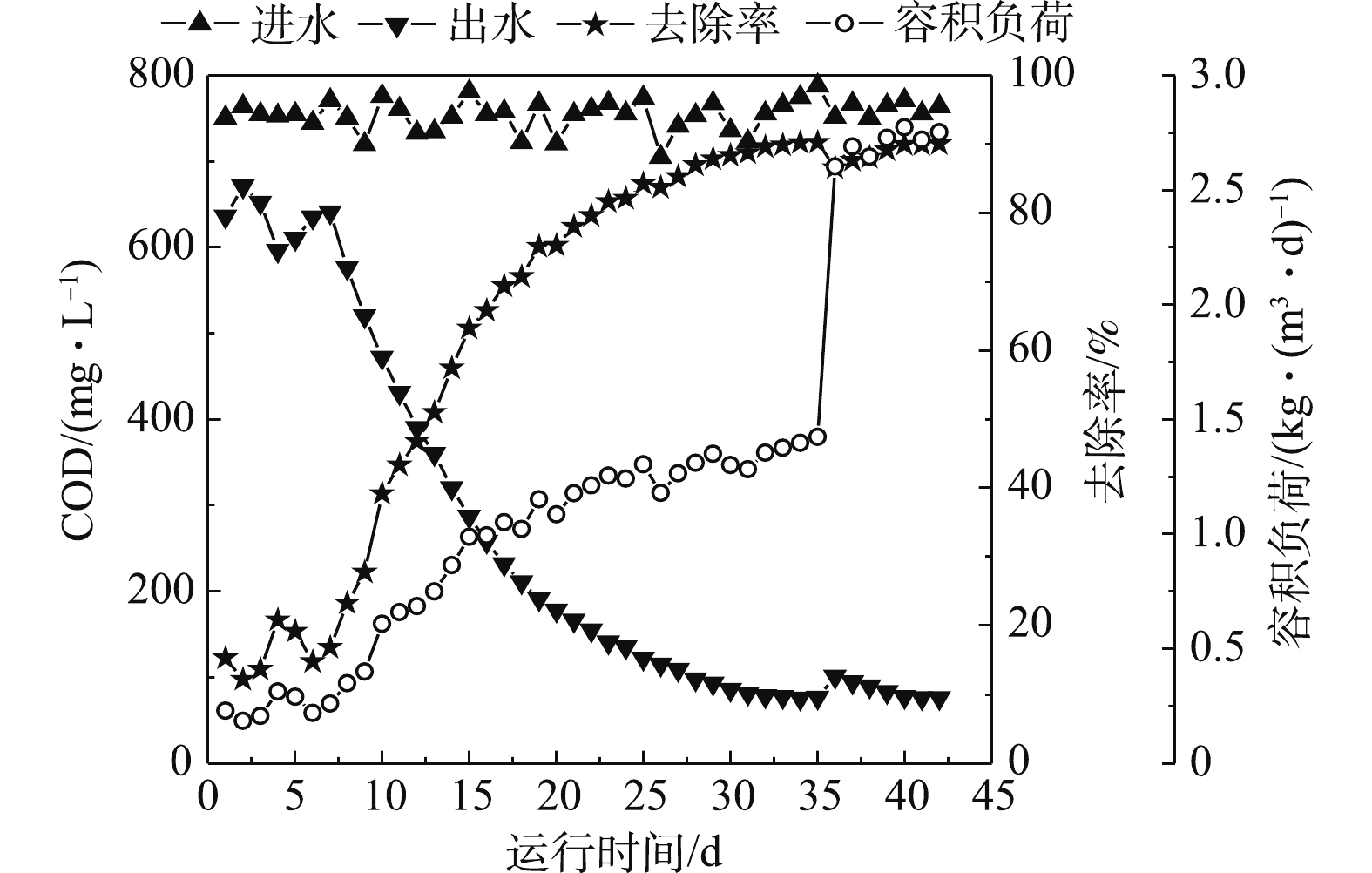-
随着中药产业的蓬勃发展,中药废水给环境带来的污染也随之加剧,引起了国家和社会的广泛关注[1-2]。中药废水具有成分复杂、有机污染物种类多、可生化性差、有毒等特点,是目前水处理领域的研究热点[3-4]。面对中药废水带来的环境问题,开发适宜于中药废水处理技术势在必行[5]。目前,我国中药废水处理工艺分为物化处理工艺和生化处理工艺。由于处理费用高,物化处理工艺普遍应用于中药废水的预处理。中药废水的生化处理工艺主要包括好氧生物法、厌氧生物法、厌氧-好氧法,其中,厌氧-好氧组合工艺是中药废水在实际工程应用中普遍采用的处理工艺。
电气石具有较强的对电极,异性电极使电气石两侧具有相反的极性,而且能把溶液的酸碱度微微调整。不管溶液最初是酸性还是碱性,均能把溶液的pH调节成偏碱性,这种环境适合产酸菌和产甲烷菌的成长和代谢[6-7]。电气石还可以降低水分子的结合程度,增加细胞的渗透性,使培养基中溶解的营养和细胞质中代谢产物更容易渗透细菌细胞膜,提高微生物活性[8-9]。将电气石与生物膜技术结合构建电气石强化生物膜系统,可极大地提高中药废水处理性能,加快推进该技术的实际应用,对实现我国“十三五”期间提出的水污染污染控制计划具有重要意义。
本研究将电气石与生物膜技术相结合,构建了电气石强化生物膜系统处理中药废水,考察了电气石强化生物膜系统的处理效果和生物膜特性,掌握了电气石强化生物膜系统启动过程的控制策略,确定了反应系统容积负荷、COD去除率和生物膜产甲烷系数等重要的运行参数,为中药废水处理提供参考。
-
取聚醚多元醇48 g、三乙醇胺1.2 g、有机硅匀泡剂0.84 g、蒸馏水2.1 mL、二月桂酸二丁基锡6 g,电气石5.1 g(电气石质量分数为8%)。将上述药品依次加入到 500 mL 的烧杯,形成组分A,将组分A进行超声10 min,在恒温20 ℃、800 r·min−1条件下搅拌3 min,使其混合均匀。取38份甲苯二异氰酸酯加入到组分A中,机械搅拌1 min,使其混合均匀,迅速倒入发泡箱中,进行发泡。发泡30 min 后开模,取出软质聚氨酯泡沫块,熟化 48 h 后,制备成TPU填料。TPU填料最终切割成2 cm×2 cm×2 cm立方体。TPU填料电气石负载量为62.5 g·L−1。TPU填料的密度、孔隙率及比表面积分别为0.47 kg·L−1、95.6%和0.39 m2·g−1。TPU填料的SEM表征结果如图1所示。
-
电气石强化厌氧流化床(AFBR)装置由水泵、水箱、生物膜反应系统等组成,其示意图如图2所示。AFBR反应系统的材质为有机玻璃,内径为20 cm,高度为100 cm,TPU填料在反应系统中的填充率为80%,有效容积25.2 L。反应系统配有恒温夹套,以保持恒定温度。反应系统采用上流模式运行,污水通过蠕动泵从底部进入反应系统,在上升过程中与填料上的生物膜接触,完成对污染物的降解。反应系统设有回流系统,保证反应系统在接种期间有足够的水力负荷,确保填料与接种污泥充分接触,缩短挂膜时间。
电气石强化好氧流化床(FBR)装置由水泵、水箱、曝气机、生物膜反应系统等组成,其示意图如图3所示。FBR的材质为有机玻璃的,内径为20 cm,高度为50 cm,TPU填料在反应系统中的填充率为80%,有效容积为12.6 L。反应系统配有恒温夹套,以保持恒定温度。反应系统采用上流模式运行,污水通过蠕动泵从底部进入反应系统,在上升过程中与填料上的生物膜接触,完成对污染物的降解。曝气机通过放置在反应系统底部的空气扩散器向反应系统提供所需氧气。为保持反应系统内的溶解氧浓度维持在2.0~4.0 mg·L−1,反应系统配置有曝气控制系统。由于TPU填料在反应系统中呈流态化,与溶液充分混合,因此我们认为溶解氧在反应系统中是均匀的。
-
实验用水来自黑龙江某中药企业生产废水,该企业生产复方丹参片、护肝片、刺五加片、脑得生片、消栓通络片、云芝肝泰片、穿心莲片、咳特灵胶囊、骨筋丸胶囊、紫杉饮片等中药品。实验取水来自该中药企业污水处理站的调节池,该水质会随企业生产情况不同而出现一定的波动,相关水质指标在每次取样后及时测定。实验废水在引入反应系统之前,用5%聚氯化铝混凝沉淀20 min,以降低进水悬浮物(SS)的浓度,使其低于50 mg·L−1。预处理后,上清液中的COD为 6 000~8 000 mg·L−1、BOD5为 1 300~1 800 mg·L−1、氨氮为40~80 mg·L−1、总氮为60~120 mg·L−1、总磷为1.0~3.0 mg·L−1、pH=4.16~7.64。为满足微生物生长需要,以尿素作为氮源,磷酸二氢钾作为磷源,调节进水C∶N∶P=300∶5∶1。废水进入反应系统之前,通过NaOH调节pH=7.0~7.5。
AFBR反应系统接种污泥取自黑龙江省哈尔滨市松浦污水处理厂污泥贮池。静置后,抽去上清液,得到浓度为40 g·L−1的浓缩污泥,在浓缩污泥中投入葡萄糖,搅拌,静置,得到呈黑色的接种污泥。将上述接种污泥接种至反应系统中,保证反应系统平均污泥浓度在15 g·L−1左右。在接种过程中,开启回流泵,保证水力负荷在0.6 m3·(m2·h)−1以上,保证填料与接种污泥充分接触。FBR反应系统接种污泥取自黑龙江省哈尔滨市松浦污水处理厂循环活性污泥系统。接种污泥主要含有丰富的好氧异养细菌和硝化细菌。松浦污水处理厂的COD和氨氮去除率分别为95.3%和89.6%。
-
1) AFBR启动。AFBR反应系统启动采用低负荷模式,反应系统在低负荷条件下可以最大限度减少污泥的流失,同时也降低了抑制性物质浓度。为更进一步缩短反应系统的启动时间,实验前期采用葡萄糖作为碳源,然后逐渐提高中药废水比例,直至进水水质完全是中药废水。启动过程按照进水中药废水比例和HRT分为6个阶段,运行参数见表1。在每个阶段末期,出水水质保持稳定,然后进入下一个阶段。通过调节反应系统恒温夹套,以保持在30 ºC的恒定温度。
2) FBR启动。AFBR反应系统启动完成后,用AFBR反应系统出水作为FBR反应系统进水。首先,处理后AFBR反应系统出水充满FBR反应系统,然后同时向FBR反应系统内添加接种污泥,污泥接种浓度保持在3 g·L−1。为了驯化接种污泥和在填料上形成生物膜,实验开始前闷曝48 h。通过调节反应系统恒温夹套,以保持在30 ºC。FBR反应系统采用连续流的模式运行,根据反应系统的容积负荷调节HRT,将实验过程分为2个阶段:在第1阶段,FBR反应系统HRT控制在12 h;第2阶段,反应系统HRT由12 h降低到6 h。
-
反应系统进出水常规指标检测参考《水和废水监测分析方法》;COD检测方法为重铬酸钾法,碱度(ALK)检测方法为酸碱滴定法[10];产甲烷活性检测方法为史氏发酵法[11];挥发性脂肪酸(VFA)和甲烷含量检测方法为气象色谱法;胞外聚合物(EPS)检测方法为阳离子树脂交换法[12];蛋白质含量采用考马斯亮蓝法[13];多糖含量采用硫酸苯酚法[14]。生物膜形貌采用电子扫描电镜(JSM-6490LV, JEOL, Japan)观察。
-
1)进出水COD变化。AFBR反应系统COD、容积负荷的变化曲线见图4。由图4可知,在第1阶段,为缩短反应系统启动时间,进水含有1 000 mg·L−1葡萄糖碳源。反应系统启动前1周,出水COD呈现小幅度的波动,此时出水SS浓度较高,可能是由于接种污泥部分老化,在水力负荷冲击下随出水排出反应系统。随着出水SS浓度的下降,出水COD快速降低,最终在第26天稳定在315.1 mg·L−1,此时对应反应系统COD去除率和容积负荷分别为85.1%和0.90 kg·(m3·d)−1。在第2阶段,反应系统提高了进水容积负荷至1.50 kg·(m3·d)−1,同时进水为稀释的中药废水,无葡萄糖碳源。此时反应系统出水COD出现较大波动,说明此时反应系统抗负荷冲击能力不强。反应系统经过1周的运行,出水COD逐渐降低,最终在第53天,稳定在763.4 mg·L−1,此时对应反应系统COD去除率和容积负荷分别为75.5%和1.18 kg·(m3·d)−1。反应系统进入第3阶段,出水COD曲线与第2阶段类似,反应系统抗负荷冲击能力仍然不强。在第4阶段,尽管进一步提高了进水容积负荷,但是反应系统出水COD波动幅度较小,在3 d后,出水COD快速降低,最终在第110天稳定在766.2 mg·L−1,此时,对应反应系统COD去除率和容积负荷分别为85.2%和2.93 kg·(m3·d)−1,这说明反应系统抗负荷冲击能力增强,生物膜培养成熟。反应系统进入第5阶段,进水完全为中药废水,出水COD曲线与第4阶段类似,反应系统仍然表现出良好的抗负荷冲击能力。在第6阶段,保持进水水质不变,通过缩短HRT提高反应系统容积负荷,而出水COD没有出现较大波动,反应系统去除率均在82%以上,说明反应系统启动成功。在第6阶段末期,反应系统COD去除率达到87.8%,容积负荷达到5.34 kg·(m3·d)−1。
2)进出水中pH的变化。AFBR反应系统进出水中pH随时间的变化见图5。由于进水添加了NaHCO3缓冲试剂,出水pH为7.1~7.8,在反应系统启动过程的绝大部分时间内,出水pH略高于进水pH。这说明反应系统发生了完整的厌氧生物代谢过程,即水解阶段、产氢产乙酸阶段和产甲烷阶段[15]。除进水水质本身具有较强的抗酸化能力,反应系统内由于电气石的存在,通过电气石的永久电极和自发极化效应,自动调节溶液的pH为弱碱性[16],因此,有利于抑制AFBR反应系统酸化。
3)出水VFA和碱度的变化。VFA是厌氧代谢过程中产氢产乙酸阶段最重要的代谢产物,也是产甲烷阶段产甲烷菌重要的代谢底物,因此,已成为是厌氧生物处理系统是重要的控制参数[17]。反应系统在高负荷条件下运行,容易出现氧化还原电位上升,VFA浓度增高,从而降低反应系统的甲烷产量。传统的厌氧生物反应系统不具备自身调节酸化的能力,是目前厌氧反应系统运行不稳定的关键问题之一。碱度(ALK)是衡量厌氧系统缓冲pH冲击能力的重要指标,厌氧反应器ALK一般在20~40 mmol·L−1[18]。AFBR反应系统出水VFA和ALK随时间的变化如图6所示。出水VFA浓度在反应系统启动初期出现了较大波动,持续时间大约10 d,这可能来自于接种污泥部分老化污泥内源代谢。随着老化污泥逐渐排出反应系统,反应系统出水VFA浓度开始迅速降低。在第25天,出水VFA浓度下降到3.0 mmol·L−1以下,尽管此后进水容积负荷逐渐增加,但出水VFA浓度一直呈下降趋势,最终稳定在2.0 mmol·L−1左右。在整个启动阶段,反应系统出水ALK为20~27 mmol·L−1,出水VFA/ALK均小于0.4,这说明反应系统有足够的缓冲能力,没有出现酸化现象,为微生物提供了良好的生存环境。
4)生物膜的特征。生物膜的形成包含2步的过程:首先,微生物附着在填料表面;然后再进一步形成致密而厚的生物膜。AFBR反应启动结束后,填料表面形成一层致密黑色生物膜。由图7可知,TPU载体中形成的生物膜由球状菌和芽孢杆菌组成,并被EPS包围。不同阶段TPU填料表面生物膜特性见表2。对于生物膜系统,第1阶段结束时,TPU生物膜质量定在60.6 g·m−2,在第2阶段末期,生物膜质量增长到65.3 g·m−2,第5阶段和第6阶段结束后,生物膜质量分别稳定在74.3 g·m−2和75.5 g·m−2,这说明微生物进入了生长平稳期,生物膜趋于成熟,生物膜形成和脱落之间存在稳定的平衡。除生物膜质量外,生物膜EPS、蛋白质含量均呈上升趋势。EPS在生物膜形成过程中起着至关重要的作用。增加的EPS可以防止生物膜脱落,也可以增加微生物对抑制环境的抵抗力[19]。蛋白质含量增加显著,而多糖浓度仅略有增加,导致蛋白质/多糖比例增加。蛋白含量升高可以限制有毒物质的扩散,保护微生物免受伤害,这些结果与SHENG等[20]的研究结果一致。
5)产气量的变化。产气量是衡量反应系统正常运行的一个重要指标[21]。AFBR反应系统不同阶段的产气量变化如图8所示。随着容积负荷的提高,反应系统的产气量逐渐增加,甲烷占比也随之增加,说明产甲烷菌活性逐渐增强。在第1阶段,由于进水负荷较低,产气量仅为7.9 L·d−1,其中甲烷占比为37.0%,甲烷产量只有2.9 L·d−1,其他气体为CO2、CO和H2S等。在AFBR反应系统启动末期,产气量稳定在42.6 L·d−1,其中, 甲烷占比达到了74.5%,甲烷产量为31.7 L·d−1。
6)生物膜的产甲烷活性。在厌氧生物技术中,产甲烷活性厌氧处理系统一个重要指标,可反映生物膜的产甲烷潜力[22]。TPU填料生物膜不同阶段的比产甲烷活性见图9。由于反应系统采用低负荷启动方式,在第1阶段,进水容积负荷为1.0 kg·(m3·d)−1,填料处在挂膜期,此时生物膜产甲烷活性也较低,为14.4 mL·(g·d)−1。随着进水容积负荷的增加,填料挂膜结束,在第2阶段结束时,生物膜的产甲烷活性升高至24.2 mL·(g·d)−1。随着运行时间的延长,反应系统内生物量逐渐增加,生物膜结构更加稳定,生物膜产甲烷活性快速的提高。在第3~5阶段结束时,产甲烷活性分别增加至52.1、90.9和115.2 mL·(g·d)−1,这说明随着进水容积负荷的增加,生物膜进入快速生长期,产甲烷活性也呈现对数增长。到了第6阶段末期,尽管缩短HRT进一步提高了进水容积负荷,但生物膜产甲烷活性小幅度升高至126.4 mL·(g·d)−1,这说明生物膜进入了稳定生长期,产甲烷活性基本达到最佳水平。
-
1)进出水COD的变化。FBR反应系统COD、容积负荷的变化如图10所示。由图10可知,在前7 d,反应系统出水COD波动较大,这个阶段生物膜没有形成,COD去除主要以吸附为主,此外,接种污泥内有部分微生物进入内源呼吸期,内源代谢释放一部分有机物质。随着生物膜逐渐出现在填料表面,从第8天开始,FBR反应系统出水COD快速降低,在第28天,出水COD降到了100 mg·L−1以下,此后逐渐降低,第35天,出水COD稳定在76.5 mg·L−1,反应系统对应的COD去除率和容积负荷分别为90.3%和1.4 kg·(m3·d)−1。此时,填料表面形成了致密的黄褐色生物膜,生物膜表面有絮状EPS围绕,这说明FBR反应系统启动成功。第36天,反应系统HRT由12 h缩短至6 h,进水容积负荷增加1倍。然而,出水COD仅出现轻微的上升,经过3 d的运行,出水COD降到之前的水平,这说明FBR反应系统具有一定的抗负荷冲击能力。中药废水经AFBR和FBR处理后,出水水质达到《中药类制药工业水污染物排放标准》(GB 21906-2008)排放要求(表3)。
2)生物膜的特征。FBR反应系统启动成功后,分别对第35天和第42天的生物膜进行扫面电镜测试,结果如图11所示。由图11可知,在FBR反应系统启动成功后,填料表面形成了致密的生物膜,主要由短杆菌和球菌组成,其镶嵌在EPS之中。生物膜内部有丰富的孔隙,可促进微生物与基质接触、吸附和物质交换[23]。在反应系统提高容积负荷后,生物膜变得更加致密,生物膜内部孔隙减少,限制了由于负荷提高引起的有毒物质的扩散,从而保护微生物免受伤害,进而维持反应系统的稳定性。
-
1)通过电气石的物化性质改善聚氨酯填料表面的微环境,结合电气石调节微生物的代谢机制,将电气石强化生物膜系统成功应用于中药废水处理中,出水水质满足《中药类制药工业水污染物排放标准》(GB 21906-2008)的排放要求,同时,反应系统表现出良好的抗负荷冲击能力。
2) AFBR反应系统经历160 d完成中药废水的启动实验,此时反应系统中COD的去除率达到87.8%,容积负荷达到5.34 kg·(m3·d)−1,生物膜产甲烷活性达到126.4 mL·(g·d)−1。填料表面形成一层致密黑色生物膜,微生物主要由球状菌和芽孢杆菌组成,且被EPS包围。
3) FBR反应系统经历35 d完成中药废水的启动实验,出水COD稳定在76.5 mg·L−1,反应系统对应的COD去除率和容积负荷分别为90.3%和1.4 kg·(m3·d)−1,填料表面形成了致密的生物膜,其主要由短杆菌和球菌组成,且镶嵌在EPS之中。
电气石强化生物膜系统处理中药废水的启动及生物膜特性分析
Analysis on biofilm characteristics and start-up of biofilm system enhanced by tourmaline treating Chinese medicine wastewater
-
摘要: 将电气石与生物膜技术结合构建电气石强化生物膜系统处理中药废水,通过电气石调节生物膜微环境,以增强微生物代谢活性,从而提高了反应系统的处理能力。结果表明:电气石强化厌氧流化床(AFBR)反应系统经历160 d完成中药废水的启动实验,反应系统COD去除率达到87.8%,容积负荷达到5.34 kg·(m3·d)−1,生物膜产甲烷活性达到126.4 mL·(g·d)−1;电气石强化好氧流化床(FBR)反应系统统经历35 d完成启动实验后,出水COD稳定在76.5 mg·L−1,反应系统对应的COD去除率和容积负荷分别为90.3%和1.4 kg·(m3·d)−1。中药废水依次经AFBR和FBR处理后,出水水质满足《中药类制药工业水污染物排放标准》(GB 21906-2008)排放要求。以上结果可为实际工程项目提供理论依据和参考。Abstract: In this study, the combination of tourmaline and biofilm technology was to build the tourmaline enhanced biofilm system for Chinese medicine wastewater treatment. The tourmaline was used to regulate the micro-environment of the biofilm, enhance the metabolic activity of microorganisms and improve the treatment efficiency of the reaction system. The results showed that after 160 d, the start-up of tourmaline enhanced anaerobic fluidized bed reactor (AFBR) for Chinese medicine wastewater treatment was completed. COD removal efficiency of the reaction system reached 87.8%, the volume loading reached 5.34 kg·(m3·d)−1, and the methanogenic activity of biofilm reached 126.4 mL·(g·d)−1. After 35 days, the tourmaline enhanced fluidized bed reactor (FBR) was completed. The effluent COD maintained at 76.5 mg·L−1. The COD removal efficiency and volume loading of the reaction system were 90.3% and 1.4 kg·(m3·d)−1, respectively. Chinese medicine wastewater was treated by AFBR and FBR successively. Its effluent water quality met the discharge requirements of Discharge Standard of Water Pollutants in Traditional Chinese Medicine Pharmaceutical Industry (GB 21906-2008). This provides theoretical support and reference for actual projects.
-
Key words:
- tourmaline /
- biofilm system /
- Chinese medicine wastewater /
- start-up
-
表 1 AFBR反应系统运行参数
Table 1. Operational parameters of the AFBR reactor
阶段 时间/d HRT/h 进水COD/(mg·L−1) 葡萄糖贡献COD/(mg·L−1) 进水负荷/(kg·(m3·d)−1) 第1阶段 1~26 48 2 000 1 000 1.00 第2阶段 27~54 48 3 000 0 1.50 第3阶段 55~84 36 4 000 0 2.67 第4阶段 85~110 36 5 000 0 3.33 第5阶段 111~144 36 6 000 0 4.00 第6阶段 137~157 24 6 000 0 6.00 表 2 不同阶段TPU填料表面生物膜特性
Table 2. Characteristics of biofilm attached to TPU carriers at different periods
阶段 EPS/(mg·g−1) 蛋白质/(mg·g−1) 多糖/(mg·g−1) 蛋白质/多糖 生物膜质量/(g·m−2) 第1阶段 162.3 88.4 59.3 1.5 60.6 第2阶段 227.4 128.4 78.6 1.6 65.3 第3阶段 275.7 168.4 82.5 2.0 69.7 第4阶段 299.7 199.7 73.1 2.7 72.6 第5阶段 317.3 221.2 67.6 3.3 74.3 第6阶段 323.1 228.4 65.7 3.5 75.5 表 3 出水水质
Table 3. Water quality of effluent
检测结果及相应标准 COD/(mg·L−1) BOD5/(mg·L−1) 氨氮/(mg·L−1) 总氮/(mg·L−1) 总磷/(mg·L−1) SS/(mg·L−1) pH 平均浓度 76.5 15.3 2.7 13.7 0.2 35.2 7.7 排放标准 100 20 8 20 0.5 50 6~9 -
[1] 殷勤, 年跃刚, 周岳溪, 等. 中药制药行业水资源再利用途径及可行性分析[J]. 工业水处理, 2018, 38(11): 12-15. [2] 李洁, 申俊龙, QIAN D. 中药资源产业化过程废弃物资源化的理论与模式分析[J]. 中草药, 2017, 48(10): 2153-2158. doi: 10.7501/j.issn.0253-2670.2017.10.033 [3] 余登喜, 丁杰, 刘先树, 等. 强化混凝预处理削减中药废水的毒性[J]. 环境工程学报, 2016, 10(11): 6133-6138. doi: 10.12030/j.cjee.201505205 [4] 冯丽霞, 赵艺, 王亚晓, 等. 两级水解/接触氧化/BAF组合工艺处理中药废水[J]. 中国给水排水, 2019, 35(6): 124-127. [5] 刘立, 刘畅, 农燕凤, 等. 中药废水处理工程设计实例及分析[J]. 中国给水排水, 2018, 34(8): 89-92. [6] JI Y B, TAN C, CUI D, et al. Enhanced effects of tourmaline on moving bed biofilm reactor-based partial nitrification process[J]. Journal of Environmental Engineering, 2019, 145(4): 91-102. [7] 韩雅红, 邱珊, 马放, 等. 电气石对反应器快速启动及生物多样性的影响[J]. 水处理技术, 2018, 44(7): 30-40. [8] TAN C, XU H R, CUI D, et al. Effects of tourmaline on nitrogen removal performance and biofilm structures in the sequencing batch biofilm reactor[J]. Journal of Environmental Sciences, 2018, 67(5): 130-138. [9] LI W L, TAN C, CUI D, et al. Influence of tourmaline on the activity of ANAMMOX bacteria and ANAMMOX reaction[J]. Journal of Environmental Engineering, 2018, 144(8): 59-68. [10] 国家环境保护总局. 水和废水监测分析方法[M]. 4版. 北京: 中国环境科学出版社, 2002. [11] 马托, 马宏瑞, 杜占鹏, 等. 硫化物在厌氧污泥中的分布和对产甲烷活性的抑制作用[J]. 环境化学, 2005, 24(5): 550-553. doi: 10.3321/j.issn:0254-6108.2005.05.013 [12] 龙向宇, 龙腾锐, 唐然, 等. 阳离子交换树脂提取活性污泥胞外聚合物的研究[J]. 中国给水排水, 2008, 24(3): 29-38. doi: 10.3321/j.issn:1000-4602.2008.03.008 [13] BRADFORD M M. A rapid and sensitive method for the quantitation of microgram quantities of protein utilizing the principle of protein-dye binding[J]. Analytical Biochemistry, 1976, 72(1): 248-254. doi: 10.1016/0003-2697(76)90527-3 [14] DUBOIS M, GILLES K A, HAMILTON J K, et al. Colorimetric method for determination of sugars and related substances[J]. Analytical Chemistry, 1956, 28(3): 350-356. doi: 10.1021/ac60111a017 [15] 张庆云, 谢学辉, 柳建设. 微生物共代谢处理印染废水研究进展[J]. 化工进展, 2017, 36(9): 3492-3501. [16] TAN C, CUI D, LIU Y, et al. Influence of tourmaline on the anaerobic ammonium oxidation process in sequencing batch reactors[J]. Journal of Environmental Engineering, 2017, 143(9): 53-64. [17] HUANG X D, XU Q X, WU Y X, et al. Effect of clarithromycin on the production of volatile fatty acids from waste activated sludge anaerobic fermentation[J]. Bioresource Technology, 2019, 288(9): 598-609. [18] 赵明明, 李夕耀, 李璐凯, 等. 碱度类型及浓度对剩余污泥中温厌氧消化的影响[J]. 中国环境科学, 2019, 39(5): 1954-1960. doi: 10.3969/j.issn.1000-6923.2019.05.019 [19] MENG D Z, WU J, CHEN K L, et al. Effects of extracellular polymeric substances and microbial community on the anti-scouribility of sewer sediment[J]. Science of the Total Environment, 2019, 687(15): 494-504. doi: 10.1016/j.scitotenv.2019.05.387 [20] SHENG G P, YU H Q, LI X Y, et al. Extracellular polymeric substances (EPS) of microbial aggregates in biological wastewater treatment systems: A review[J]. Biotechnology Advances, 2010, 28(6): 882-894. doi: 10.1016/j.biotechadv.2010.08.001 [21] 闫强, 韩文彪, 陈灏, 等. 连续式两相厌氧消化的产气潜能[J]. 环境工程学报, 2018, 12(4): 1246-1253. doi: 10.12030/j.cjee.201710121 [22] 李俊生, 谭冲, 夏至, 等. UASB反应器处理PTA废水的启动及污泥特性分析[J]. 环境工程学报, 2018, 12(9): 90-98. [23] 李青, 成小英. 不同填料生物反应器中脱氮微生物群落比较分析[J]. 安全与环境学报, 2017, 17(6): 2360-2365. -







 下载:
下载:

